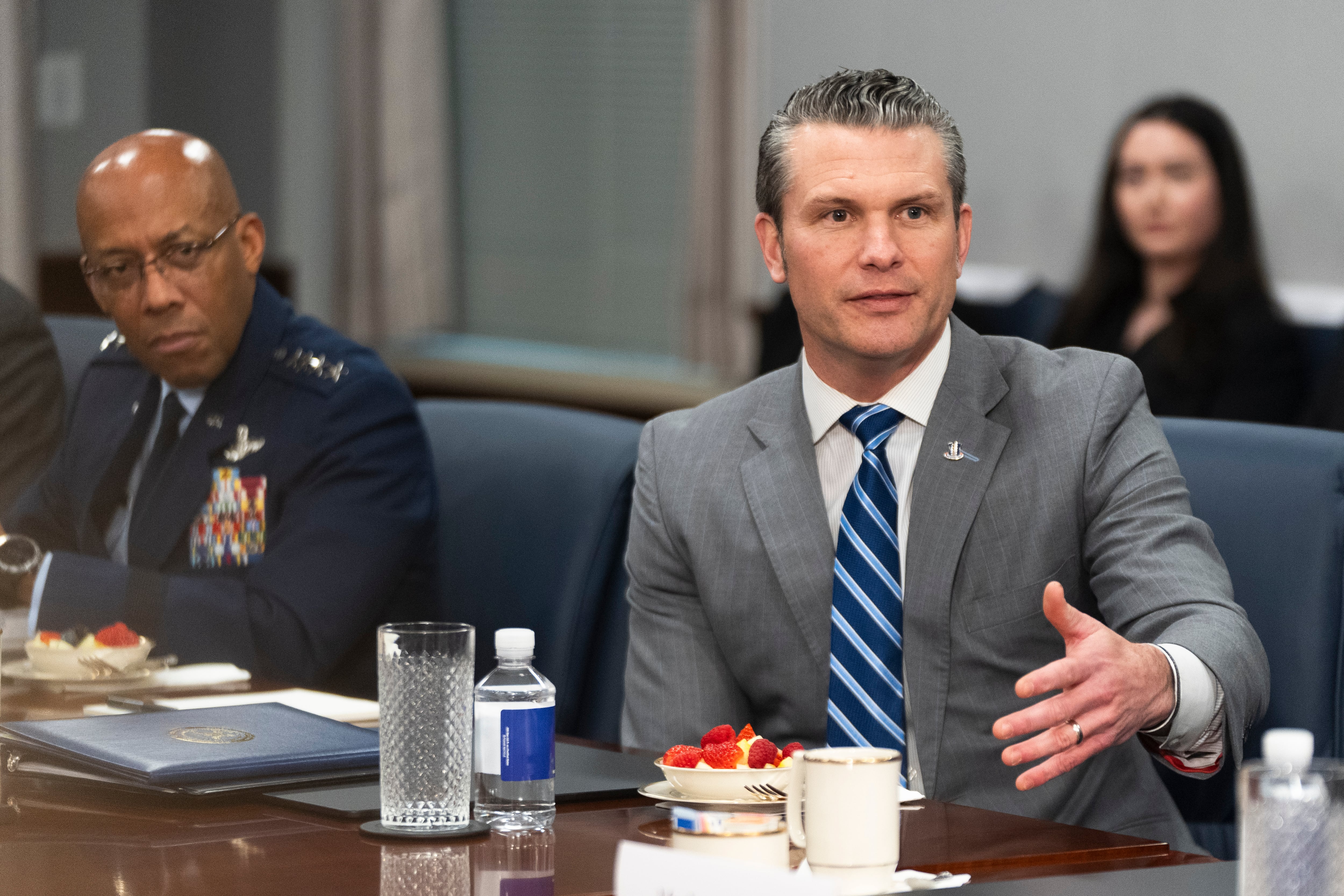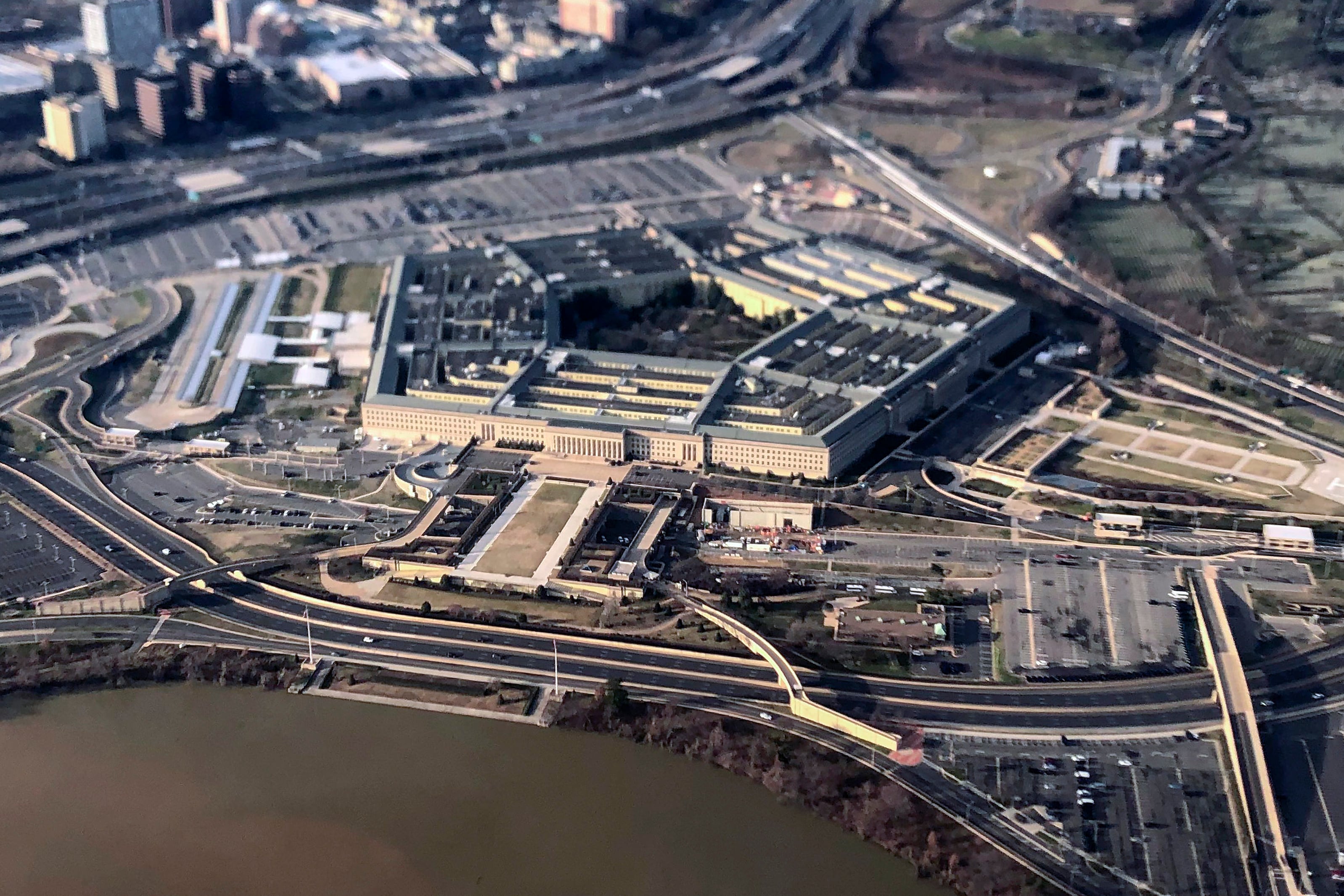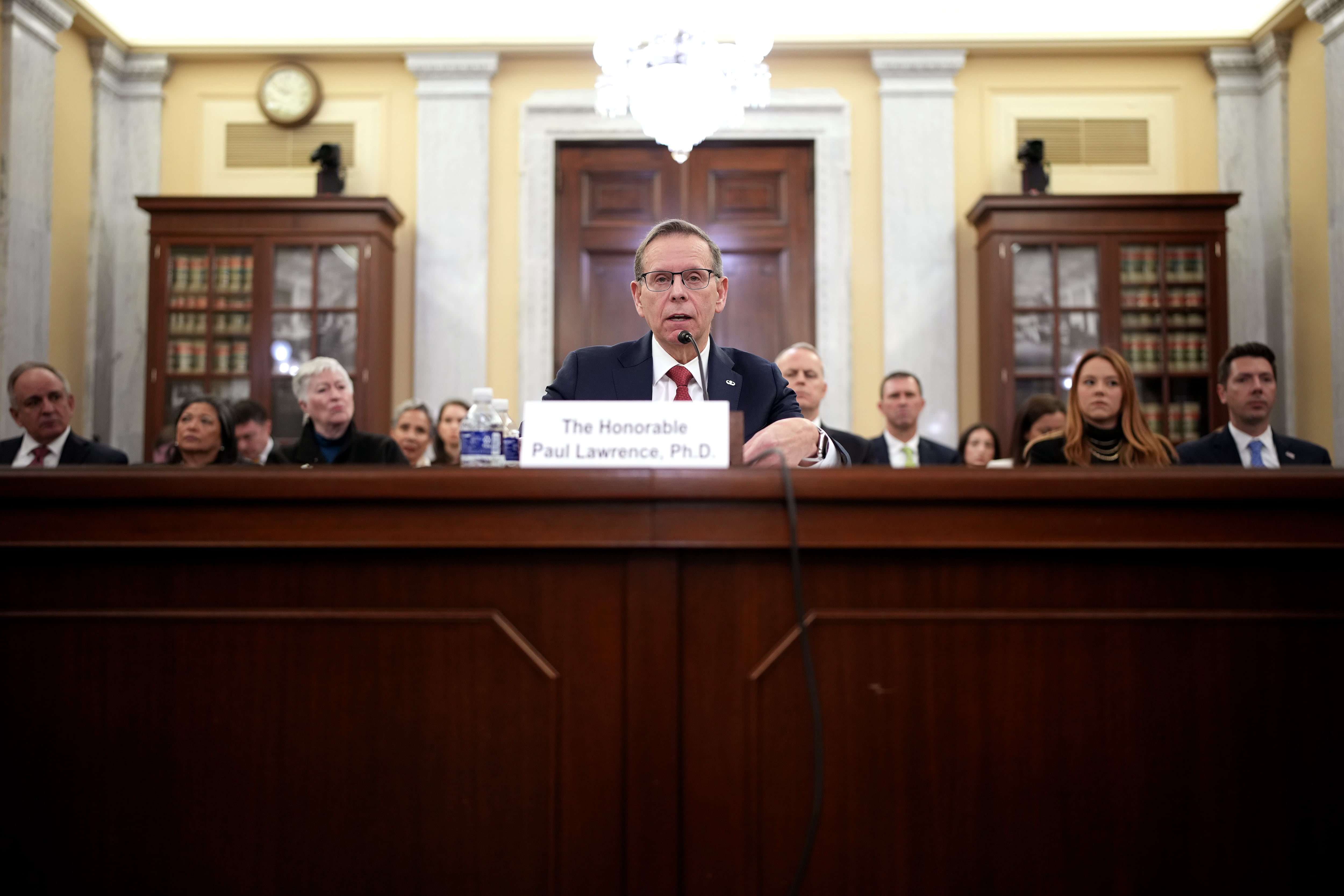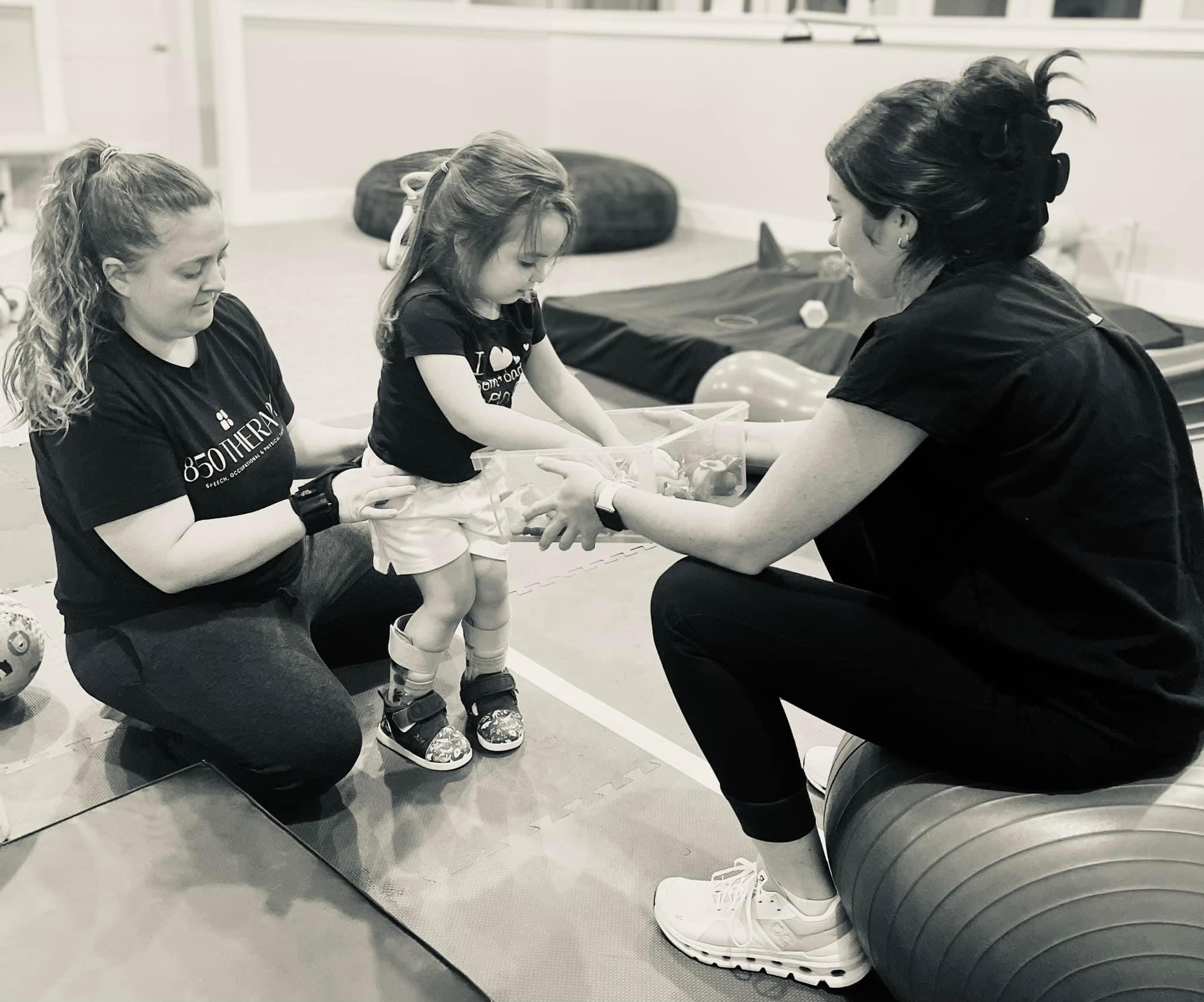Mike Stevens knows what it's like to be accused of breaking traditions.
As the 13th master chief petty officer of the Navy, he has faced outrage and dismay over his decision two years ago to "respectfully sundown" the practice of chief's induction — and all the alcohol and misinappropriatebehavior and alcohol abuse that often came with it — in favor of tough, professional training that marks a sailor's entrance into the fleet's most coveted ranks.
"Tradition is a word that's thrown around a lot, but not many really take the time to fully understand what it means and put it in the proper context," Stevens told Navy Times. "It all goes to how you choose to understand and define what tradition really is."
But Stevens has spent time doing just that. Two years ago, he asked Master Chief Information Systems Technician Jim Leuci, a drilling reservist with the Naval History and Heritage Command, to scour the history books and find the origins ground trust of chief's induction.
His report, "A Tradition of Change — CPO Initiations to CPO-365," is the first official research of the history of CPO rites, and charts changes from the days of tossing selectees off the pier to the more elaborate and frat-house like rituals of recent decades.
"One of the things I learned from the research … is that many of our traditions are those things we have experienced during our time of service," Stevens said. "It's strongly based on what we have experienced."
The Navy is full of formal traditions — rendering honors to the flag and to individuals by ringing a set number of bells, or a specific call on a bosun's whistle — and many of these have long been laid down in Navy edicts and instructions. The Merriam-Webster dictionary defines tradition as "a way of thinking, behaving, or doing something that has been used by the people in a particular group, family, society, etc., for a long time."
"There's a definition of tradition, but how you interpret that is really all about your service and your time, "Stevens said. "You came in the Navy and we were doing X and while you were in, and then we stopped doing it. We then view that as a break in tradition — regardless of how long that perceived tradition has been around."
Given the facts in the new report, to be released April 1 in honor of the observed CPO birthday, Stevens says chief's initiation doesn't quite fit the mold of a tradition, though he realizes some chiefs will disagree.
"I know CPOs didn't come into existence until 1893, but in the now nearly 122 years since then, initiation has only been around for roughly half that time," Stevens said.
It's never been formally mandated by the Navy or consistent, Stevens added.
"When you look at the historical record and the facts, it's pretty obvious that much of the initiation process was essentially entertainment for the genuine chiefs of the day," Leuci said. "But when you step back and look at it over time, the process has grown much more difficult — and often forcibly mandated reform — it has grown and made the transition itself into a tough professional training program designed to prepare first classes to be effective chiefs."
Stevens says he's comfortable with the ending of the initiation and said the professional training is tough, meaningful and beneficial to the selectee, their commands and the service.
Evolving roles
One of the most popular targuments in favor of reasons held up by many to justify need for chief petty officer initiations is the fact that chief's today are considered separate and distinct from the rest of the enlisted ranks and therefore need a rite of passage.
This wasn't always the case.
"Today, The role of the chief petty officer has evolved [from] one that fits between the the officers and the rest of the enlisted ranks," said Master Chief Information Systems Technician Jim Leuci, author of "A Tradition of Change — CPO Initiations to CPO 365," a new report that chronicles the evolution of chief initiations. in the chief petty officer ranks told Navy Tmes"Really, it's a role that has evolved over time."
Research shows, Leuci said that role of the chief has evolved over time — as has their now hallowed place as leaders as well as technical experts and
April 1, 1893, is commemorated held up as the chief petty officer birthday and today it's celebrated by khaki balls and other events, but at the time, the service didn't announce the arrival of "the chief" with much fanfare.
A Navy circular — an early equivalent to today's NavAdmin messages — was sent out to commands announcing the establishment of a the "chief petty officer classification" effective April 1.
Leuci says Navy-wide there were 57 sailors advanced to that rank when that day arrived.
"However, the appointment of the first chief petty officers was not a major event of the day," Leuci wrote in the soon to be released report. "The first chief petty officers of 1893 were not immediately elevated to a higher enlisted status as a result of their appointments." In fact, there is no mention of the establishment of the CPO ratings in the Secretary of the Navy's annual reports to the U.S. Congress in 1893 or 1894."
Those reports to Congress were to announce all the major accomplishments of the service for each year and making chief's — such a large event today — didn't even show up on the service's radar screen as anything more than an administrative move.
Chief's messes weren't immediately established, nor did now chiefs get new uniforms either — they didn't even get paid differently right away, Leuci found.
"After April 1, 1893, chief, first, and second class petty officers shared the same mess," he wrote. "For nearly ten years, chief petty officers continued to mess and berth with first and second class petty officers."
That all changed in 1902, however, when as a a change to Navy regulations formally established a separate mess for chief petty officers. All other enlisted men were consolidated into one general mess. It was the first time all enlisted didn't mess and berth together as they had since the Navy's founding. was established in 1775.
Going overboard
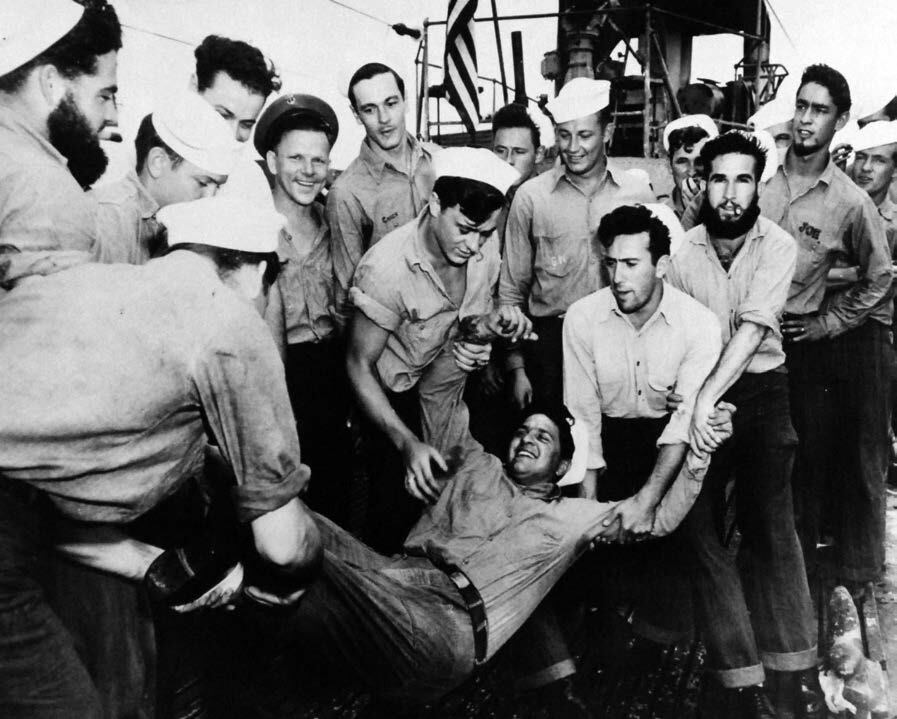
Shipmates of John O. Tibs toss him overboard from the submarine Bream at Pearl Harbor upon his promotion to chief machinist's mate during World War II. This form of CPO initiation was often followed up with a few beers ashore.
Photo Credit: National Archives
For those who hold up chief's initiations as long standing traditions in the Navy, Leuci says they need to look at the historical record.
For six decades almost 60 years after the establishment of the CPO rank and over 40 years after chief's where set aside as their own separate class of enlisted sailors with their own messing and berthing, there still was no such thing as chief's initiations.
Once advanced, a new chief moved into the chief's mess and picked up where he left off.
"There is really no record of initiation before World War II," Leuci said. "When you talk to those who made chief during this time, you can see the beginnings of start to evolve, though it was more of a jovial and social event — there was no formal training — nothing like it has evolved to today."
During his research for the report, Leuci said he talked to multiple WWIIorld War II and Korean War chiefs. They either didn't recall an initiation or said it was relatively simple petty officers who either don't recall an initiation of any kind — or for whom it was relatively simple — they went swimming.
Consider the story of Chief Yeoman (SS) Albert Dempster. He Leuci said, was very similar to the stories of all those he interviewed about their initiation into the chief's ranks during and after the war. Dempster, Leuci wrote in the report, joined the Navy in 1940, signing on for an initial six-year hitch. He served on submarines before and during the war, making four war patrols on the submarine Crevalle in the Pacific, operating out of Fremantle, Australia. It was during one of these patrols that he got word that he and one of his shipmates had advanced to chief.
"There was no CPO initiation while they were underway in the South China Sea," Leuci wrote. "When Crevalle returned to Fremantle, Australia, the two new chiefs were initiated. Their initiation consisted of being thrown over the side of the boat, followed by drinking at a local bar. Dempster remained in the Navy after the war and retired as a chief yeoman in 1960."
"Though they were called initiations at the time, they weren't secret events, though they generally happened behind closed doors in the chief's mess," Leuci said.
The fact that chiefs existed for so long before the emergence of induction rites after WWII cast doubt on the oft-heard arguments that chief initiations are a sacred right or intrinsic to the role of CPO, said so many years between the establishment of chief petty officers to the emergence of initiations after World War II casts into doubt the arguments of many chief's that initiations are traditions, according to Master Chief Petty Officer of the Navy (AW/NAC) Mike Stevens.
"Buy definition, traditions are long standing things, over time," he said. "So based on the historical record, one could argue that by establishing the process of initiation in the first place was a departure from the long standing tradition of the day."
Traditions of convenience
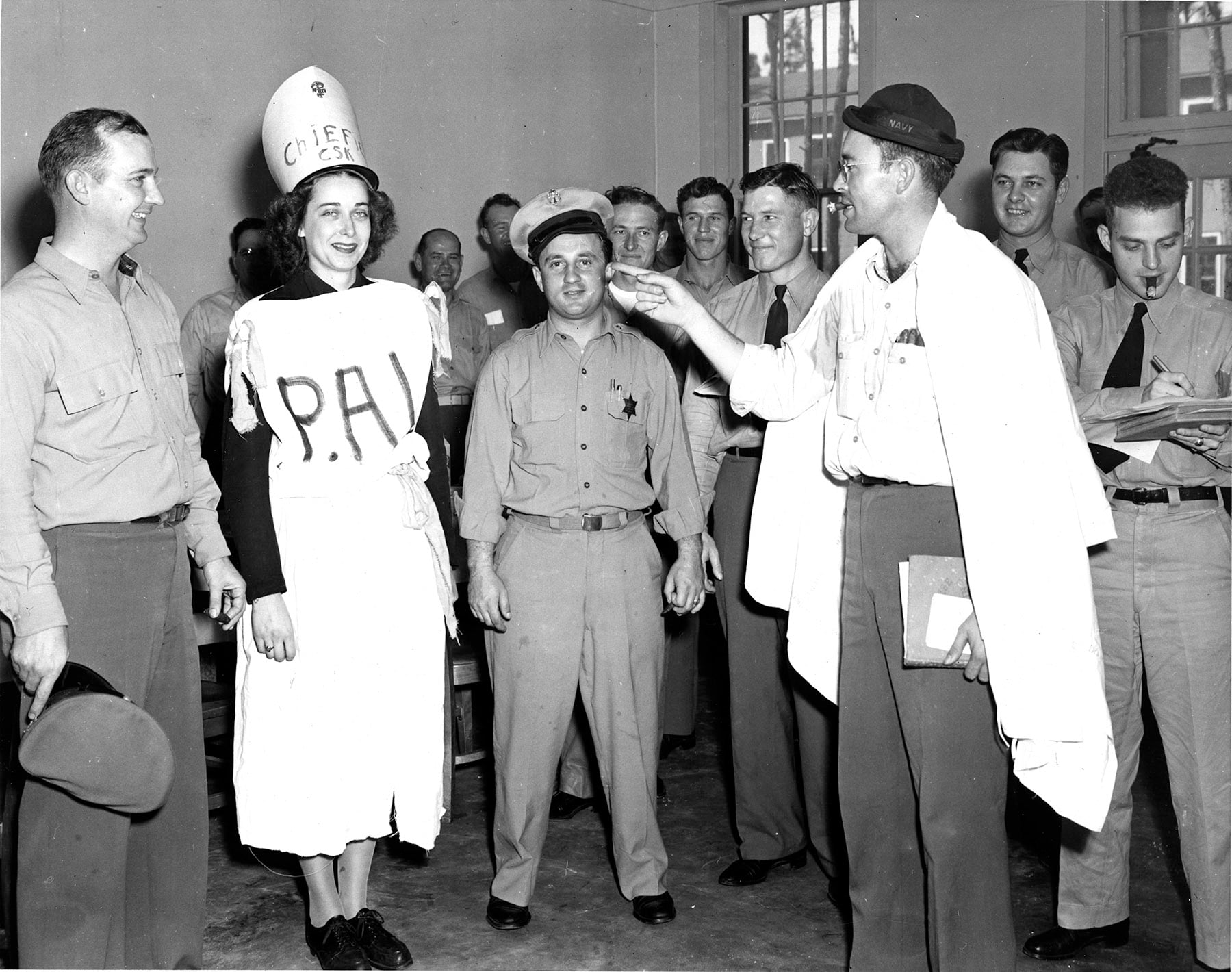
A female chief storekeeper faces the 'judge' and 'sheriff' during her 1948 initiation. Many of the early CPO initiation rituals were borrowed from shipboard crossing the line ceremonies at the Equator.
Photo Credit: Naval History and Heritage Command
Today, when new chief selectees go through the Phase II of CPO-365, which begins after the Navy announces who's been selected for chief each summer, they are given charge books to carry during their final stages of becoming a chief petty officer. When they are pinned, the book is put inside an ornate wooden box or "vessel" as it is called todayas a keepsake of their transition into the chief's mess.
"Charge books — There are lot of myths about these and where they came from," Leuci said. "The going story is charge books were carried by petty officers in World War I and chiefs would penoften write advice in them, and though this is a nice story, there's really not a lot of evidence to back it up — I won't say it's not true, but there's not really the evidence to support the story."
What the evidence does shows, he said, is that they seem to have started appearing in the 1960's. And though in the day, some were kept as keepsakes, many weren't.
Then as today, the book was a repurposed green Navy log book that often was fixed to a chain or rope and worn around the selectee's neck of the select as they moved towards their final initiation day.
"It was simply a place to document the transgressions of the chief select so they could be read by the judge at their initiation," he said.
Far from the hallowed objects of today, Leuci writes that these logbooks often were fouled by initiation rites run amok. things often became disgusting things, too, as the imaginations of the chief's conducting the initiations got carried away.
Former MCPON Duane Bushey said , who went through initiation in 1974, as saying he threw his charge book away after he finished his initiation in 1974.
"Bushey had a charge book that was stolen a few days after he got it," Leuci wrote. "It wasn't returned until a week before initiation.
"The book had been spit on, ejaculated on, defecated on, and was full of profanity ridden comments. After initiation he threw the book away."
Even Leuci's own charge book from his 1988 initiation was defaced.
"I asked a chief to put his X in the book and he took the request literally and made an X on the cover with a fire axe," he said.
Other traditions and keepsakes have been added over the years, many taken from crossing the line ceremonies known for forcing the uninitiated wogs to eat or crawl through food. there have been other keepsakes over the years, too.
"There are other official Navy photographs dating from the mid-1950s that show new chief petty officers in wash khaki or dress uniforms participating in various events such as eating their first meal in the CPO mess from a wooden trough," Leuci said.
Selects would build make the troughs to specifications they were given and on their initiation day would eat from it either with a large spoon — or with no utensils at all and their hands tied behind their back. These were traditions of convenience, borrowed from other rites, and not intrinsic to the role or the training to be a chief. They were simply disgusting and often degrading.
Many kept these troughs as keepsakes
"But it doesn't appear that they ate anything different than the other chief's in the mess in those troughs," Leuci said, "unlike many initiations in later years where many inedible things were required to be eaten. At my own initiation I was required to eat raw eggs through a condom."
Borrowed traditions
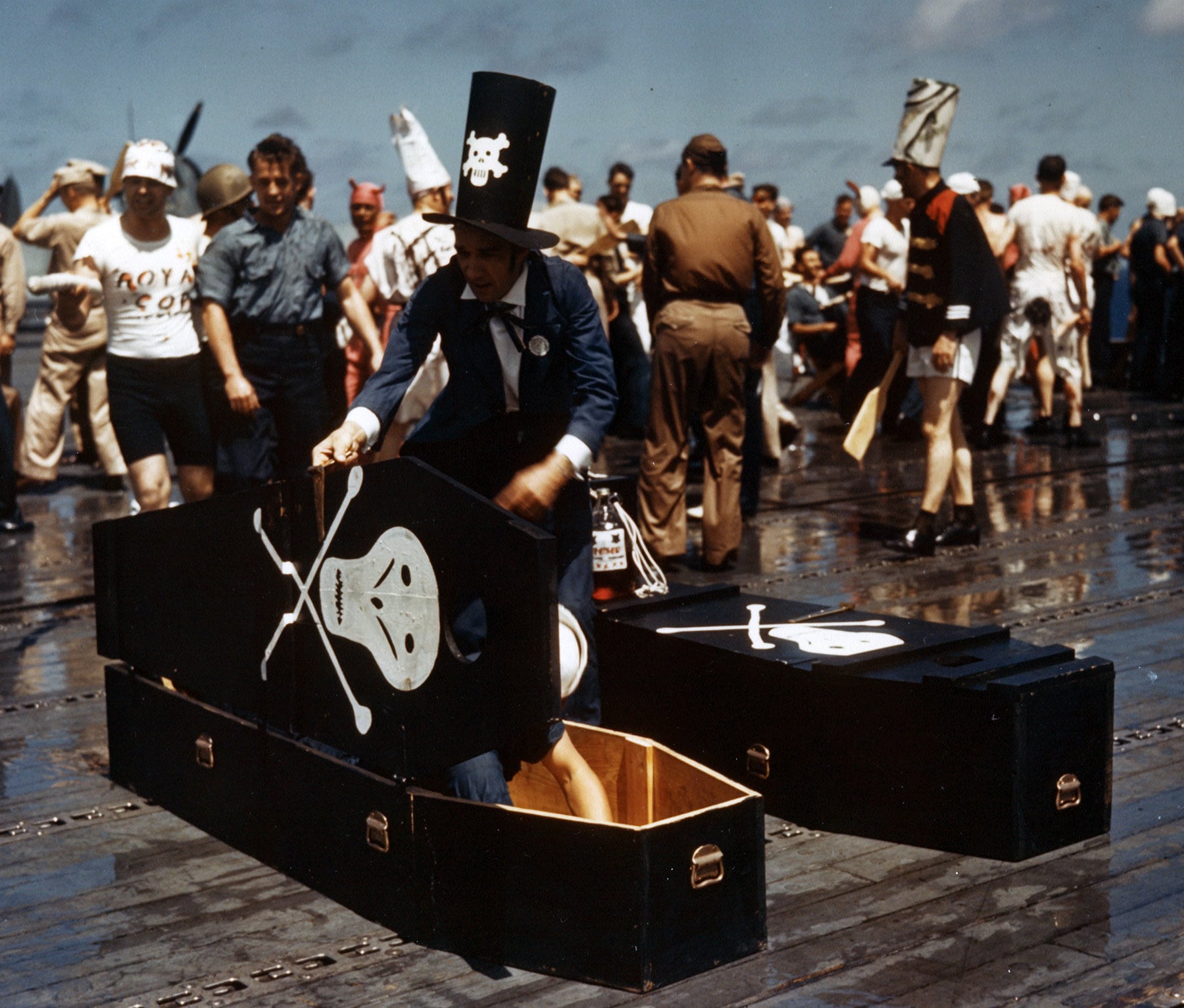
New chief petty officers in 1965 prepare to eat from a trough, either with a large spoon or with no utensils at all and their hands tied behind their backs.
Photo Credit: Naval History and Heritage Command
The old saying that there's nothing new under the sun could also apply to the evolution of chief's initiations and especially on initiation day, when the selectee faces a judge who lists a litany of transgressions and shortcomings. went in front of a judge to have their transgressions as a chief select and their shortcomings as potential chief petty officer outlined to them.
Defenders of these events say that what is endured during initiation hammers home the idea that chiefs must work together as a group — as a mess — to accomplish things. They can't do it alone, and they need to listen to the experience and wisdom of those who came before if they hope to be successful as a chief.
Others disagree and believe that and see no value in the kind of shenanigans are degrading and lack and believe it degrades and provides no redeeming training value.
The facts show that much of what became chief's initiations in the 1960s and lasted for decades was borrowed from other naval ceremonies — especially those from the rite of crossing the equator and becoming a "shellback." that of becoming a shellback from crossing the equator.
"Some of the rituals seen in crossing the line ceremonies, such as eating distasteful concoctions of food products and drinking 'truth serum,' were adopted for CPO initiations," Leuci said. "Some of the props used in crossing the line ceremonies such as stocks and ice-filled coffins began to be seen in CPO initiations. Characters like the 'judge,' 'defense attorney,' and 'sheriff' became fixtures as CPO initiations essentially became mock trials or kangaroo courts."
Other induction rites borrowed from "tacking" on crows for junior sailors or "blood pinning," where shipmates puncture a sailor's skin with newly awarded As these features were added, many of the practices that became common in CPO initiation's, like other traditional events of the day including crossing the line, tacking on crows for junior sailors and even "blood pinning" where military pins and qualification insignia are placed on an individual and pushed in without anything on the pins to protect the individual from getting stabbed.
These rituals things all made it into chief initiations, Leuci said, adding that the "practices and events were in direct conflict with Navy regulations relating to hazing, bullying, and harassment — especially when viewed by today's standards," he said. "However, the attitudes of senior enlisted and officer leadership of the 1960s and 1970s were often tolerant of questionable practices as long as there were no serious injuries and no serious complaints."
In the 1990s as Navy leadership sought to rein in the initiation antics, some chiefs fought back and offered voluntary alternatives, away from the Navy's prying eyes and rules.
"There were reports that some CPO messes offered 'traditional' initiations to interested selectees that were not sanctioned by the Navy and were held off-base," Leuci said."It seems almost ludicrous."
"It seems almost ludicrous," Leuci said "But apparently that was the case."
Pranks and controversy
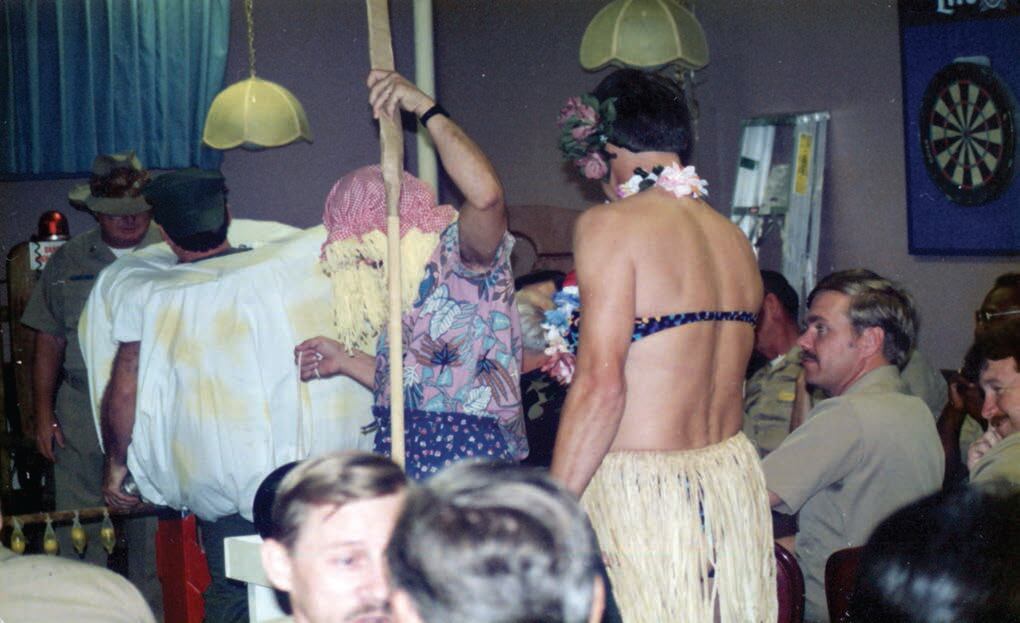
The line between having fun at chief initiations and humiliation or even hazardous pranks blurred more often in the 1970s and after.
Photo Credit: Navy
Nearly every MCPON has had to deal with some sort of initiation controversy during his time wearing the three-starred crow that is the symbol of the office.
That started with Starting with Master Chief Gunner's Mate Del Black, the service's first MCPON. Black had to respond to chiefs outraged that a 1967 instruction prohibited "haazardous or detrimental" rites, or that involved "unbecoming conduct." That was widely interpreted to mean that informal initiations would be replaced by formal ones, with none of the fun and games.That started in Del Black, who had to clarify to outraged chief's that a 1967 Navy instruction that stated that CPO initiations and crossing the line ceremonies were ok as long as they were not "hazardous or detrimental and do not involve unbecoming conduct" meant that the "informal" initiations should be placed with formal ones with none of the fun and games.
But in what became the first ever initiation guidance issued by the Navy, Black wrote in the January 1968 issue of All Hands Magazine that fact it just wasn't so.
"There is no objection to CPO initiations conducted in a humorous vein, but at the same time, they should not be hazardous," Black wrote in an article in the January 1968 All Hands Magazine, in what was the first initiation guidance. "Proper supervision and planning can ensure that the honor and pride that go with making chief are not overshadowed by fun and games. We should not force the initiates to eat or drink against their wishes, nor should we do anything that could lead to bodily injury."
Black went on to say that the chiefs conducting the ceremonies should "avoid any humiliation to the initiate."
Despite Black's prohibitions, Leuci wrote, initiations went on unabated.
"Many provisions of SECNAVINST 5060 were generally ignored," Leuci wrote in the report. "Alcohol abuse, the consumption of food concoctions, unsafe events and the humiliation of CPO selectees remained the norm."
Sometimes things got so bad that a few times the chief of naval operations tried actually sought to shut down initiations altogether.
"Every MCPON, starting with [William] Plackett through Scott, was confronted with concerns about, or actual orders to end, CPO initiations from the Chief of Naval Operations," Leuci wrote. "Discussions to eliminate CPO initiations were generally kept out of the media and were not common knowledge within the fleet."
Such was the case during the time Duane Bushy was MCPON in the early 1990s. Nearly every year as chief's initiations happened, there were usually reports of alcohol-fueled misconduct at initiationsrelated incidents.
But In 1988, then-CNO Adm. Carlisleyle Trost and members of Congress were drawn into the debate by "reports of lewd, crude, and disgusting behavior during initiations" which were reported directly to them, according to the report.
The straw that broke the CNO's back was a complaint of a lewd incident in Groton, Conn. where newly Nine newly minted chiefs came down with strep throat after being forced to put a plastic facsimile of a male penis in their mouths, one after another. The disease was then transmitted to family members, according to accounts told to Navy Times by sources close to the discussions.
Leuci mentions the incident, but not does not describe exactly what spread the disease, citingsaying only unsanitary conditions during the initiation were the cause.
"Adm. Trost informed [Bushey] that he was ready to eliminate CPO initiations," Leuci wrote. "Instead, Bushey was able to present a plan to reform initiations that the admiral accepted."
This led to a crackdown. Alcohol use by selectees was banned from the events. Promises were made to hold command master chiefs accountable for degrading or hazardous conduct at inductions. Officials expanded the rules to banning selectees from performing any acts against their will. and rules were expanded so that out of line initiations and prohibitions were expanded from simply banning selects from eating or drinking anything against their will to now extending that ban to performing any acts against their will.
"The reforms were not popular among all CPO messes," Leuci wrote. "However, even though some CPO messes were slow to accept or simply ignored the MCPON's guidance, the reforms had begun."
A few years later, Leuci said, in the wake of the Tailhook scandal, both CNO's Adm. Frank Kelso and also Mike Boorda, too, threatened elimination of initiations, but this time it was MCPON John Hagan who saved initiations from the scrap heap by instituting reforms accepted by the Navy's leadership.
Nearly every MCPON since has issued some sort of reform to the existing system, instituting formal leadership training and other more acceptable and arguably more beneficial ways of welcoming in new chiefs each year.
It was Stevens in 2013 who took the final step, and moved the process to one that mandated a totally professional transition, eliminating all alcohol from any formal events and ending chief's initiation and the sophomoric antics that had so long gone with it. as well as any sophomoric antics altogether.
Frocking, boards and chief's season
What many don't know isThe current practice of having a "chief's season," where all newly selected chief petty officers are either promoted or frocked to their new paygrade on Sept. 16, has only been in practice since 1980.
And it's only been since 1974 that the Navy has held a selection board to review and select eligible first-class petty officers for advancement to chief.
Before that time, ese two events occurred, advancement to chief petty officer was pretty much a year-round affair, with advancements — and initiations — being held nearly every month as a new crop of chiefs earned their anchors. put on their new rank.
Just As with petty officers today, there were twice-annual chief chief petty officer exams given for advancement to chief petty officer.
And also like petty officers today, these exams were graded and a final multiple score based on that test score and the sailor's annual evaluations ranked the candidates. Those on the list were promoted in their order of ranking.
These lists, according to Leuci's research, were mailed to commands.
"A posted advancement list was the way that most sailors found out they were selected for chief," Leuci wrote. "CPO promotion lists promulgated by naval message did not become common until the late 1960s."
Frocking — the practice of allowing someone to wear the rank and assume the rights and responsibilities of the next pay grade — wasn't authorized, yet.
Once the selection board was established and the first one held in 1974, the twice a year lists went away and a single annual list was published.
But since there was still no frocking allowed — Advancements and initiations continued in monthly increments year round as before until 1980 when frocking was authorized for all enlisted paygrades.
In 1980, unrestricted frocking was authorized throughout the enlisted ranks.
So, when the selection boards met that year and the results were released in July, the Navy held its first "chief's season," where all those selected were either advanced or frocked in September — a practice and timeline -- that has continuesd until today.
Covers and khakis
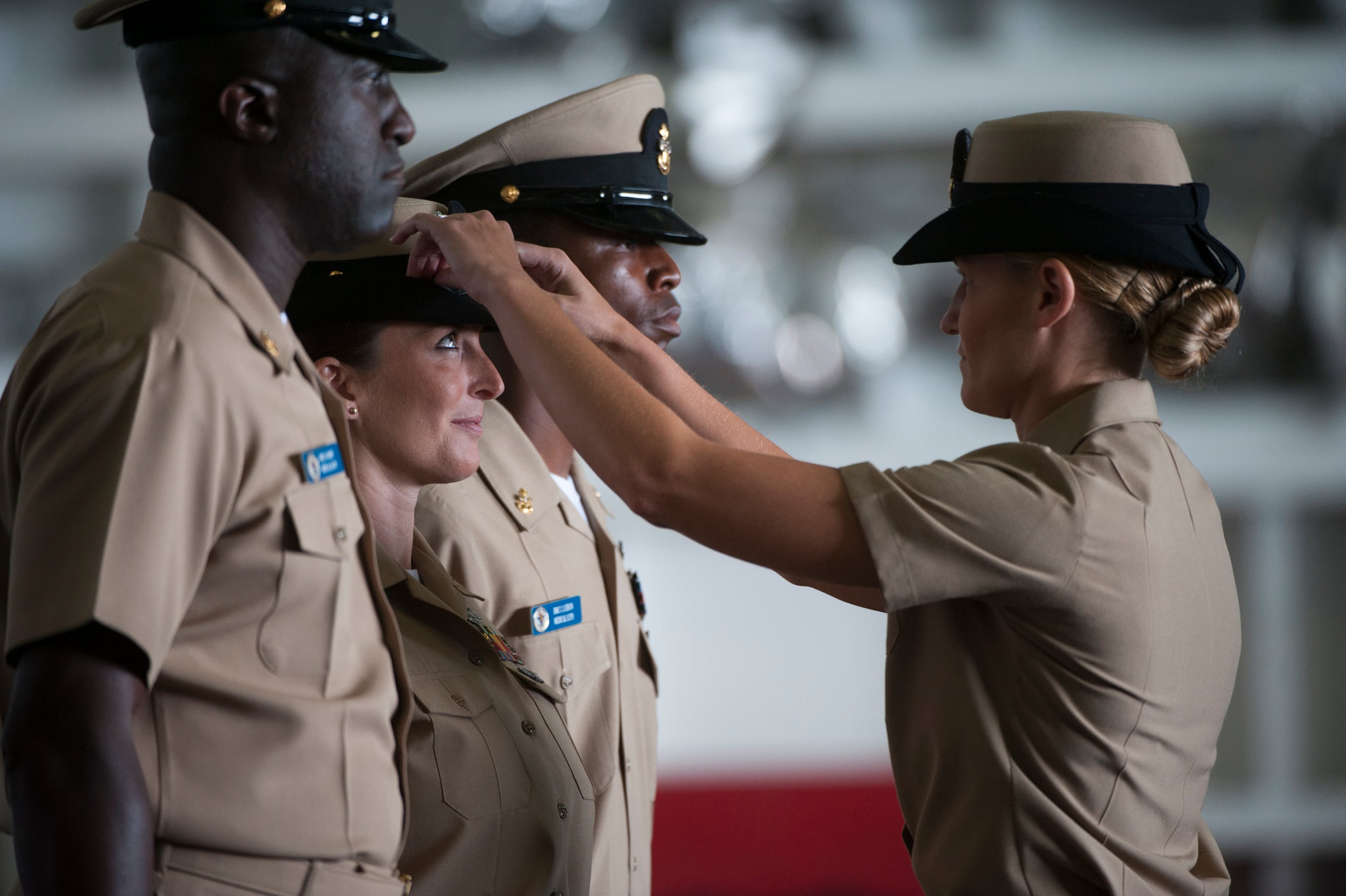
The longest-standing symbol of a chief petty officer is their cover. Chief Hospital Corpsman Tarren Windham dons hers at a 2013 ceremony aboard aircraft carrier Carl Vinson.
Photo Credit: MC2 Timothy A. Hazel/Navy
The last tradition in a pinning ceremony is also the oldest: the donning of the chief's cover.It may be the last part of a chief's pinning ceremony — but it was the first and for many years, the only real sign of a chief petty officer — the hat.
Today, it's considered tradition that chiefs petty officers and officers wear combination covers and khakis, but that wasn't much the same when it comes to uniforms, but that wasn't always the case.
Like with much of the Navy's uniform history there's little tradition, really and a whole lot of change and evolution through the years.
Though From the start, chiefs wore a separate dress uniform, but the day to day working uniforms for all enlisted sailors was dungarees. The only way to recognize a chief was by his or her their hat. anyone could tell tell a chief from the rest of the crowd, was by their hat.
Khaki working uniforms wereas first authorized only for aviation chiefs who were qualified pilots in 1929. That happened in 1929. It wasn't until 1941 that the Navy authorized khaki as a working uniform for chiefs and officers.
But when the Navy went to the Navy Service uniform and adopted a khaki short for all, many in the chief's ranks cried foul, believing khaki was exclusive tradition only for E-7 and above.
The came cries returned when the at Navy Working Uniform appeared and eliminated the wash khaki's, many chief's cried foul again that traditional things were being done away with. But had they looked at their history, Leuci said there was just as long a tradition that chief's wore dungarees and were only differentiated by their hats.
And The chief's fouled anchor of the chief petty officer made it's first appearedance in 1897 as a cap device only — anchor collar devices were still almost sixty60 years away. Since then, it's been reworked. Initially the anchor was just pinned to the cloth of the cap, but later it was put on a background, like just as the officer's insignia.
Though the shape of the anchor and the placement of the letters USN were later moved slightly the elements are the same. Today, chiefs are taught an alternate meaning for the USN on their covers, that it stands for and the anchor and chain it restssits on, stating that it stands for unity, service and navigation.
And many, Leuci says, believe that was how the anchors were decided on as chief's insignia, when in actuality it was the other way around.
None of that Leuci said, has been passed down from the first chief petty officers to the present — they were all alternate means created along the way as teaching tools — traditions of convenience.
"It's a nice tradition that someone made up," Leuci said.
Even the practice of pinning was created as the process went along. Until 1959, 55 years ago, collar devices weren't worneven authorized. They were added after the creation of the E-8 and E-9 pay grades in 1958.
But according to Leuci, Initially, all three paygrades wore the same fouled anchor without the stars we know today. Separate collar devices for each paygrade came in 1961.
"When you step back and look at it all, it's not so much tradition as it is an evolution, a process of constant change," Leuci said. "But no matter what the evidence says, there will always be those who think that any change is bad."
Mark D. Faram is a former reporter for Navy Times. He was a senior writer covering personnel, cultural and historical issues. A nine-year active duty Navy veteran, Faram served from 1978 to 1987 as a Navy Diver and photographer.

